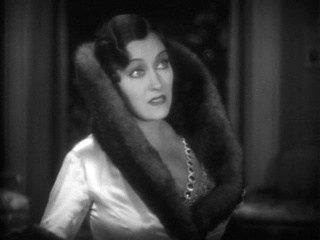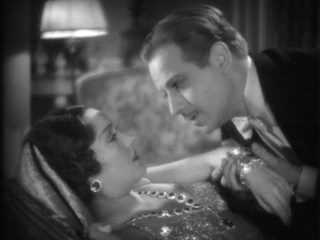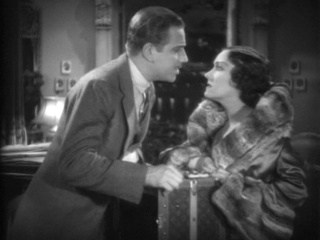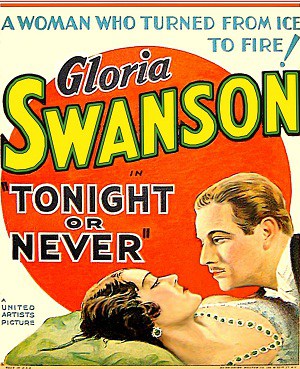Gloria Swanson’s known today primarily as the star of 1950’s Sunset Boulevard, a film which plays on her stardom in the era of silent films. What get lost in the shuffle is that Swanson made roughly a half dozen of sound pictures prior to Sunset Boulevard, starting with her Oscar nominated performance in 1929’s The Trespasser.
Coming roughly halfway through these sound pictures is 1931’s Tonight or Never, a film with more than a little trivia behind it. It’s not only one of Swanson’s few talking pictures where she doesn’t sing (ironic as she play an opera singer here) and is also the first picture with wardrobe completely by Coco Chanel. It also has some nice cameos from Boris Karloff (as a waiter) and J Carol Naish (as a radio announcer). It’s also the first screen appearance of Melvyn Douglas.
Packaged as a comedy, Tonight or Never is built around Swanson as opera singer Nella Vago in what can only be termed the minor leagues of the opera circuit (if there is such a thing). She’s playing places like Budapest and Venice, which though surely nice don’t have the artistic appeal of Berlin or say, Vienna. She’s endlessly envious of other singers being signed by a representative from the Metropolitan Opera to sing in New York.
 Her challenge according to those around her, most notably her teacher Rudig (Ferdinand Gottschalk) is that her singing- though technically very good- lacks the passion and emotion that comes from one who has experienced love. After yet another adept but soulless performance in Venice she notices a strange man outside her window chain smoking. Though intrigued by the mystery man, Nella heads back to Budapest, learning later that her secret admirer is also on the train with her.
Her challenge according to those around her, most notably her teacher Rudig (Ferdinand Gottschalk) is that her singing- though technically very good- lacks the passion and emotion that comes from one who has experienced love. After yet another adept but soulless performance in Venice she notices a strange man outside her window chain smoking. Though intrigued by the mystery man, Nella heads back to Budapest, learning later that her secret admirer is also on the train with her.
Back in Budapest, Nella learns not only that her fiance (whom she does not love- Warburton Gamble as Count Albert von Gronac) is cheating on her but also that the Metropolitan Opera’s representative is in town recruiting talent. Hoping perhaps for the love that will enable her to elevate her art enough to get her signed to the Met, she decided to seek out her mysterious follower and pay for the love she needs. (She’s also since learned that rumor has it that he’s a gigolo.)
 In perhaps the best scene of the film, she confronts Jim (Douglas) and basically throws herself at him. Though the censors went mad about the scene at the time, it’s of course staid by today’s standards. We’ll leave the rest of the plot for you to discover.
In perhaps the best scene of the film, she confronts Jim (Douglas) and basically throws herself at him. Though the censors went mad about the scene at the time, it’s of course staid by today’s standards. We’ll leave the rest of the plot for you to discover.
For a film built entirely around her, it’s strange that Gloria Swanson looks so fidgety and nervous throughout. Though she’s mostly exceptional when speaking (like many silent stars whose voices were entirely unsuitable for sound pictures), she lacks the comedic timing to make the interplay humorous. Many of the scenes with Melvyn Douglas and most notably the one above could have been even stronger with improved timing.
Though others have cited director Mervyn LeRoy’s habit throughout the picture to go soundless in long scenes where Swanson is alone onscreen as a strength of the picture, another perspective emerges more strongly. It’s entirely possible (though also hypothetical) that LeRoy knew that Swanson was struggling a bit and instead gave her these scenes which drew heavily on her silent experience to bolster flagging confidence. She’s still strong throughout, but comedy (at least in sound pictures) wasn’t her strong suit.
 What can’t be criticized is that Swanson looks outstanding in a plethora of gowns by Coco Chanel, with each being more effective than the last. This is especially noteworthy as Swanson was pregnant at the time which necessitated numerous additional fittings.
What can’t be criticized is that Swanson looks outstanding in a plethora of gowns by Coco Chanel, with each being more effective than the last. This is especially noteworthy as Swanson was pregnant at the time which necessitated numerous additional fittings.
Sadly, she seems to overindulge during these same scenes, with each expression and body movement grossly exaggerated. At times her movement here (which is entirely normal outside of these scenes) appears robotic and inflexible. Though perhaps working for her at the time, these scenes look dated now and likely even did then as well. Even by 1931 most pictures only remaining transitional aspect was the prevalence of over enunciated diction and a minimal amount of background noise. Both were done to permit a clear sound for film.
The balance of the cast continues roles they learned on Broadway in the play on which Tonight or Never is based. Among these is Melvyn Douglas himself, who works hard and to varying degrees of success in getting Swanson to get on board. Douglas of course went on to have a long and mostly distinguished career, coming close to reprising this role in 1939’s Ninotchka.
